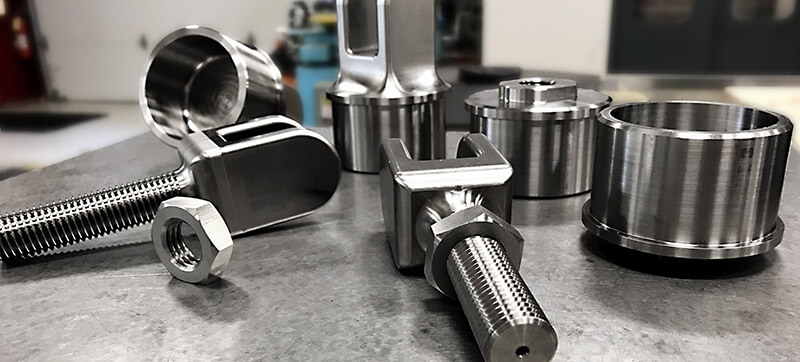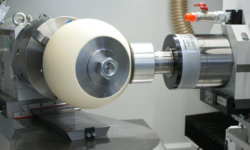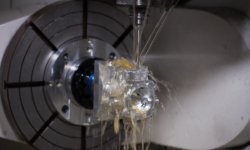With its excellent strength-to-weight ratio and resistance to corrosion, titanium is one of the most useful and popular metals for industrial engineers, architects, and consumer product designers. It is named after the Titans of Ancient Greek mythology, after all, and it usually lives up to its name.
Titanium has desirable material properties, and it is also relatively easy to work with. It is weldable (in an inert atmosphere) and it can be CNC machined like stainless steel. It is also conducive to virtually all surface finishing processes: bead blasting, powder coating, and electrophoresis all produce good results when applied on titanium. Of course, there are metals with a higher degree of machinability than titanium, but titanium offers a good combination of formability and mechanical performance.
That being said, designing and manufacturing titanium parts is not always the same as it is for aluminum parts or parts made from low-cost materials. And since titanium blanks cost around 10 times as much as Aluminum 6061, you’ll want to make sure you get your parts done right the first time around.
This post discusses the basics of CNC machining titanium, including the most suitable applications, machining considerations, and surface finishing options.
What is titanium?
Titanium is a lustrous transition metal discovered in the UK in the 18th century. It has a silvery appearance and, despite its low density, is extremely strong. This makes it a valuable commodity in industries where lightweighting is especially important.
In addition to its good strength-to-weight ratio, titanium is also highly resistant to corrosion — from sea water, chlorine, and acids — and is non-toxic even in large amounts. This makes it particularly useful in the medical world, for implants and other medical devices.
In the manufacturing industry, titanium is often alloyed with elements like iron, aluminum, and vanadium.
Why use titanium?
Despite its premium price tag, titanium is an incredibly popular material. Reasons to use titanium include:
- High strength
- Corrosion resistance
- Good strength-to-weight ratio
- Ductility
- Good machinability
- Surface treatment options
- Recyclable
For these reasons, titanium is regularly used in industries like aerospace, automotive, and medical.
Titanium aerospace CNC machining include aircraft engine parts, airframe parts, rotors, and compressor blades. In fact, aerospace drives the production of titanium: two thirds of all the produced titanium in the world goes into aircraft engines and airframes.
In the medical world, titanium parts include surgical implants (such as long-term hip replacements) and instruments. The metal is also used for items like wheelchairs and crutches.
Why CNC machine titanium?
To get the most accurate and affordable titanium parts, CNC machining is almost always the best manufacturing technique. To understand why, let’s look at the alternatives.
Manufacturers rarely make titanium parts by casting. This is because heated titanium reacts violently with oxygen, and many refractory materials used in casting contain trace amounts of oxygen.
A workaround is to use rammed graphite casting — using an oxygen-free graphite cast — but this produces parts with a very rough surface texture not suitable for most medical, aerospace, and industrial applications. It is also possible to make titanium parts with lost wax casting, but this requires a vacuum chamber.
A newer option is the use of additive manufacturing for titanium parts. A handful of 3D printing technologies, like Selective Laser Melting (SLM), Electron Beam Melting (EBM), and Direct Energy Deposition (DED), can process titanium 3D printing materials. However, these 3D printing systems are very expensive, and many industries have not yet certified 3D printed titanium for safety-critical end-use parts.
Compared to the alternatives, CNC machining is an accurate, safe, versatile, and affordable way to make titanium parts.
Things to consider when machining titanium
Titanium is an excellent material for many applications, but it has its own unique characteristics that must be respected during the CNC machining process. Things to consider when machining titanium include:
Buildup of heat
Titanium alloys can be harder than common CNC machining and milling materials like aluminum alloys. This can result in increased tool wear and, simultaneously, an increased heat buildup at the point of contact.
For these harder titanium alloys, it may be necessary to reduce the CNC machine RPM while using a larger chipload. A high-pressure coolant can also ease the strain on your cutting tools and help produce higher-quality titanium parts.
Some commercially pure titanium (Grades 1–2) may be less liable to generate excess heat but precautions should still be taken.
Galling
An issue more prominent with commercially pure titanium than titanium alloys is galling and built-up edge.
Titanium grades 1–2 can become gummy during machining and can end up sticking to the cutting tool. However, this can be mitigated by using high-pressure coolant and ensuring swift chip removal.
Failure to address this problem can also compound the issue of heat buildup, accelerating the dulling of cutting tools.
Workholding
Titanium and its machinable alloys are less rigid than other common metals, and they therefore require a tight grip during CNC machining.
In addition to a rigid machine setup, it can be beneficial to maintain constant tool motion without interrupting the cut.
Surface finishes for machined titanium
CNC machined titanium parts can be improved with a variety of surface finishing treatments — for functional or aesthetic purposes.
Surface finishes include:
- Smoothing
- Polishing
- Bead blasting
- Brushing
- Painting
- Chroming
- Metallizing
- PVD coating
- Powder coating
- Electrophoresis
Common titanium grades
|
Titanium Grade |
Strength |
Corrosion Resistance |
Formability |
Uses |
|
1 |
Low |
High |
High |
Airframes, heat exchangers |
|
2 |
Medium |
High |
High |
Airframes, aircraft engines, marine |
|
3 |
High |
High |
Medium |
Airframes, aircraft engines |
|
4 |
High |
High |
Medium |
Airframes, aircraft engines, medical, hydraulics |
|
5 (6AL-4V) |
Medium |
High |
High |
Airframes, turbine engines, medical |
3ERP is a respected provider of titanium machining services and parts and is highly experienced in the production of titanium parts and prototypes. Get a free quote now.







